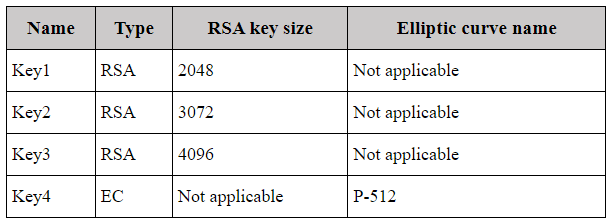

Microsoft Certified: Azure Security Engineer Associate - (AZ-500) Exam Questions
Question 1 Single Choice
You have an Azure AD tenant.
You need to ensure that users cannot create passwords containing a variation of the word Contoso.
What should you configure?
Question 2 Single Choice
You have an Azure subscription named Sub1.
In Azure Security Center, you have a workflow automation named WF1. WF1 is configured to send an email message to a user named User1.
You need to modify WF1 to send email messages to a distribution group named Alerts.
What should you use to modify WF1?
Question 3 Single Choice
You have an Azure subscription that contains an Azure SQL database named SQL1 and an Azure key vault named KeyVault1. KeyVault1 stores the keys shown in the following table.

You need to configure Transparent Data Encryption (TDE). TDE will use a customer-managed key for SQL1.
Which keys can you use?
Question 4 Single Choice
Note: The question is included in a number of questions that depicts the identical set-up. However, every question has a distinctive result. Establish if the solution satisfies the requirements.
Your company has an Azure subscription linked to their Azure Active Directory (Azure AD) tenant.
As a Global administrator for the tenant, part of your responsibilities involves managing Azure Security Center settings.
You are currently preparing to create a custom sensitivity label.
Solution: You start by creating a custom sensitive information type.
Does the solution meet the goal?
Question 5 Multiple Choice
Your network contains an Active Directory forest named contoso.com. You have an Azure Active Directory (Azure AD) tenant named contoso.com.
You plan to configure synchronization by using the Express Settings installation option in Azure AD Connect.
You need to identify which roles and groups are required to perform the planned configuration. The solution must use the principle of least privilege.
Which two roles and groups should you identify? Each correct answer presents part of the solution.
NOTE: Each correct selection is worth one point.
Question 6 Single Choice
You have 10 on-premises servers that run Windows Server 2019.
You plan to implement Azure Security Center vulnerability scanning for the servers.
What should you install on the servers first?
Question 7 Single Choice
Note: This question is part of a series of questions that present the same scenario. Each question in the series contains a unique solution that might meet the stated goals. Some question sets might have more than one correct solution, while others might not have a correct solution. After you answer a question in this section, you will NOT be able to return to it. As a result, these questions will not appear in the review screen.
You have a hybrid configuration of Azure Active Directory (Azure AD).
You have an Azure HDInsight cluster on a virtual network.
You plan to allow users to authenticate to the cluster by using their on-premises Active Directory credentials.
You need to configure the environment to support the planned authentication.
Solution: You deploy Azure Active Directory Domain Services (Azure AD DS) to the Azure subscription.
Does this meet the goal?
Question 8 Multiple Choice
You have an Azure subscription that contains 100 virtual machines and has Azure Defender enabled.
You plan to perform a vulnerability scan of each virtual machine.
You need to deploy the vulnerability scanner extension to the virtual machines by using an Azure Resource Manager template.
Which two values should you specify in the code to automate the deployment of the extension to the virtual machines? Each correct answer presents part of the solution.
NOTE: Each correct selection is worth one point.
Question 9 Multiple Choice
Your company has an Azure SQL database that has Always Encrypted enabled.
You are required to make the relevant information available to application developers to allow them to access data in the database.
Which two of the following options should be made available?
Question 10 Single Choice
You are troubleshooting a security issue for an Azure Storage account.
You enable Azure Storage Analytics logs and archive it to a storage account.
What should you use to retrieve the diagnostics logs?





